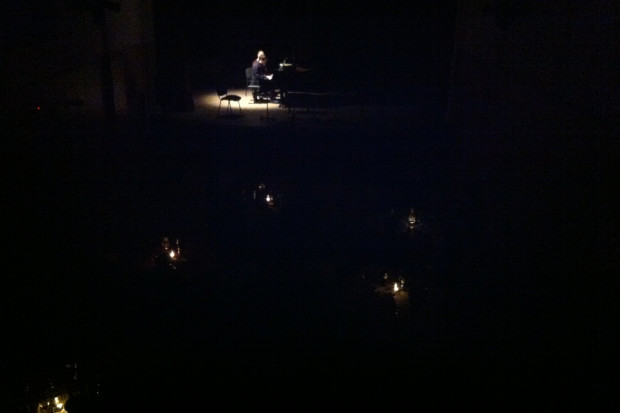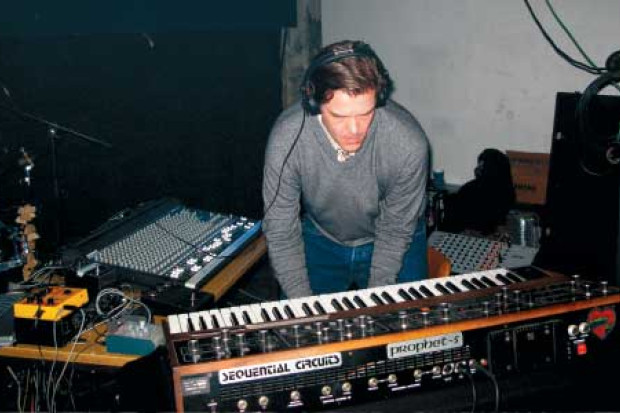
Xenia Pestova Bennett (Photo: Dimitri Djuric)
Nostalgia, Decay and Defiance
This Diatribe label debut features two related works by composer/pianist Xenia Pestova Bennett: the five-part Glowing Radioactive Elements, and title work Atomic Legacies, which also features the playing of the Ligeti Quartet.
On a casual first listen it is easy to think this is a collection of pieces for piano and electronics, composed of some simple manipulated samples. But by the time you are halfway through opening track ‘Radium’, the realisation dawns that perhaps there is something else going on – maybe it’s the undeniable flavour of metallic string-hum underpinning the sounds, or the apparent seamlessness of the gestures between acoustic and electronic.
The reality is that on this album there is no border between the two. All the sounds heard were created acoustically and the pieces performed recorded (in whole takes with no edits) on a Magnetic Resonator Piano. The MRP, created by Andrew McPherson, uses electromagnets to vibrate the strings, opening a world of sustained tones, dynamic changes and new timbres to the performer.
Pestova Bennett uses the six tracks of this album to explore this world, first inching outward on tiptoes, then in great strides, before returning again with the quiet assured steps of someone who knows their way intuitively. With the MRP, the piano ceases to be a percussive instrument subject to the laws of, in her words, ‘inviolable earth-bound principles of attack and decay’, and becomes a subtler, more expressive thing. Pestova Bennett is capable of smooth glisses, tone modulations that can be infinitesimal or swerving, and resonances that build, ebb and flow rather than just fade away.
Physical gestures
It is the sense of motion that is the most compelling thing about all the tracks of this album. The gestures feel physical, incredibly pianistic, for example that first track, ‘Radium’, which opens with crystalline and ringing sweeps in the higher register, moving slowly downwards and merging with the trembling notes of the piano, continuously shimmering and pulsing until plunging into the roiling lowest notes of the instrument.
Pestova Bennett describes this album in her liner notes as ‘navigating nuclear nostalgia’, providing both the macro and micro views of the persistence of radioactivity in both its physical and cultural forms. It is this kind of inevitable leaking that best describes how the characters of the individual named elements and associated colours inflect the five pieces of Glowing Radioactive Elements.
In the second tarck, ‘Plutonium’’s mid-range tremolos and jittery rolls are underpinned by a warm red glow; in green ‘Tritium’, a simple two-note motif grows outwards, its timbre manipulated so that it sometimes harmonises sweetly, sometimes beats against itself. Of the five, silver white ‘Actinium’ is the movement that stood out most to me; containing many of the same sweeping timbral shifts that simultaneously create motion and harmony, but also harder edges. There is less of the piano here, the keyboard present instead in an organ-like warmth, but there is a sense of danger in this lesser-known element, a buzzing metallic heart that disrupts and disturbs as it is gradually revealed.
This slow revealing of a central truth from nostalgia is also key to the longer work, Atomic Legacies, which closes the album. In the case of this piece, this heart seems to be the inevitability of the idea of decay: the MRP may have freed the pianist from this ‘inviolable earth-bound principle’, and yet it persists as an ineluctable act of both chemistry and music. The four movements are named ‘Half-life’, ‘Atomic Elegy’, ‘Forbidden Mechanism’ and ‘Decay’.
This piece opens with the grating, glissing strings of the Ligeti Quartet: at first a constant, colour-shifting drone, evolving into a perpetual rise and decay pattern which borrows from ‘Actinium’, before devolving into anxious juddering. The presence of the MRP is subtler here, providing extra depth and movement in ways that would be easy to miss, and without the nature-defying elongation and constant timbral change of the other pieces. The final movement is where the sense of nostalgia returns, in strains of Haydn’s ‘Sun’ quartet (Op. 20, No. 1), so tentative as to seem like almost faded memories, tinted by the briefest of suspended notes – a final defiance – from the piano.
To purchase Atomic Legacies by Xenia Pestova Bennett on vinyl, visit https://shop.diatribe.ie.
Published on 22 April 2020
Anna Murray is a composer and writer. Her website is www.annamurraymusic.com.









